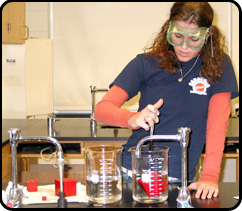Learning Goals
A recent version of the Cubes & Liquids learning goals is presented below. (A more updated version can be found here.)
 Distinguishes Observation from Inference
Distinguishes Observation from Inference
Does the learner faithfully depict what they observe or do they contaminate their observation with assumptions, inferences, and explanations? Do they conclude (unjustifiably) that a cube was placed in a beaker of water, or are they careful (and true to their observation) in specifying that the cube was placed in a beaker of liquid.
- 1. Records observations; makes no unnecessary inferences
- 0. Makes inferences where only observations are called for
Technical Description
Does the learner describe the events that transpired in an experiment in such a way that a person who was not present to observe the experiment can re-construct the salient elements sufficiently to repeat what occurred? In this case the salient elements are all those that might be related to understanding why specified cubes are or are not floating in specified liquids.
- 2. Provides an unambiguous technical description of every event
- 1. Provides an unambiguous technical description of all but one event
- 0. Does NOT consistently provide unambiguous technical descriptions
Density of Solid Objects – Coordinates Mass and Volume of Solid Objects
Does the learner coordinate the mass and volume of solid objects? Do they understand that when an object sinks, that another object of equal weight and smaller size will also sink int hat liquid? Do they know when there is insufficient information concerning the relationship of the density of a solid object to the density of a liquid which it is immersed to make a valid prediction? If so, it is because they are coordinating the mass and volume of the solid object.
- 2. Correctly coordinates mass and volume of solid objects
- 1. Attempts to coordinate mass and volume of solid objects
- 0. Does not coordinate mass and volume of solid objects
Density of Liquids – Coordinates Mass and Volume of Liquid
Does the learner coordinate the mass and volume of liquids? Can they take a situation in which they have been given the mass and volume of a cube (say 2 cc’s and 1 gram) and describe the properties of liquids in which that cube would float? Can they do so without using the word density? To solve this they must decompose a quantity of water into its mass and volume and describe the relationship between them.
- 2. Correctly coordinates mass and volume of liquid
- 1. Attempts to coordinate mass and volume of liquid
- 0. Does NOT coordinate mass and volume of liquid
Uses a 2×2 Classification Scheme to Organize Relevant Factors
Is the learner able to organize the possibilities inherent in the interaction of two factors each with two levels? See Inhelder and Piaget (1956, 1964)
- 2. Forms a COMPLETE classification scheme including all levels of both factors
- 1. Forms an INCOMPLETE classification scheme including all levels of 1 factor
- 0. Does NOT form a scheme to classify objects
Proportional Reasoning – Coordinating Solid and Liquid Densities
Does the learner coordinate solid and liquid densities? In this Activity, they are given the mass and volume of a cube. They are asked to describe the properties of a liquid such that the cube would float in it. They are not permitted to use the word ‘density’ in their answer. Their answer to this question reveals that extent to which they are able to form ratios (mass/volume of solid and mass/volume of liquid) and to competently compare these ratios to solve the problem.
- 2. Correctly coordinates 2 ratios
- 1. Attempts to coordinate ratios
- 0. Does NOT attempt to coordinate ratios
